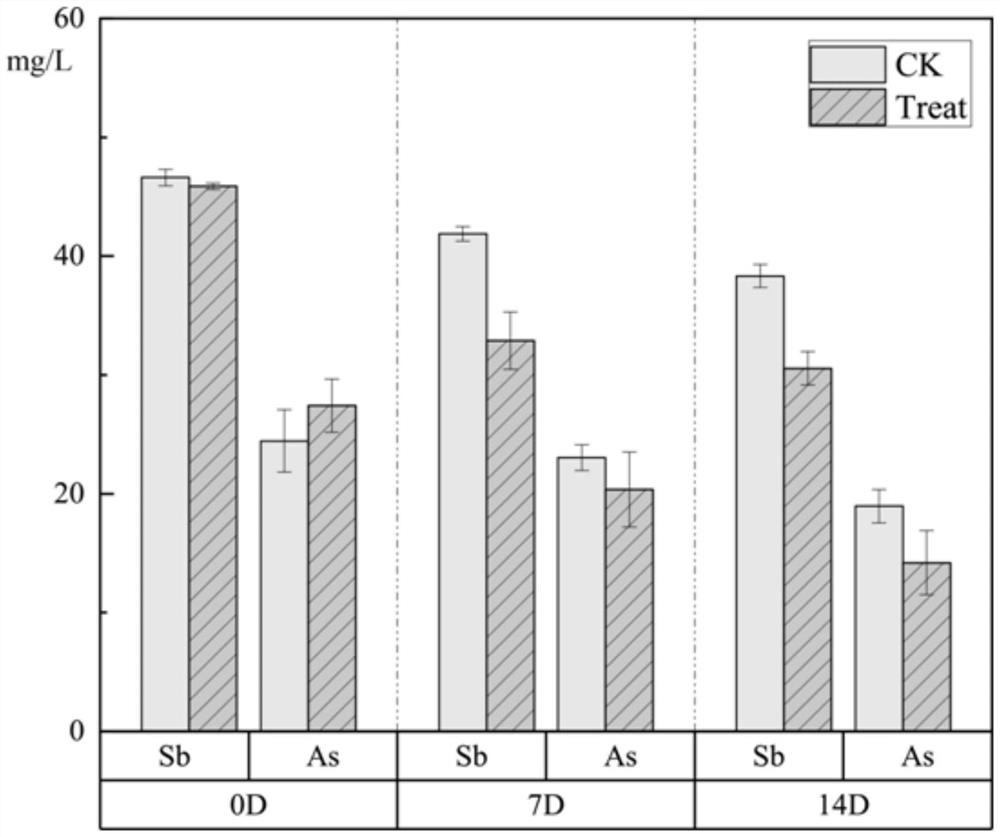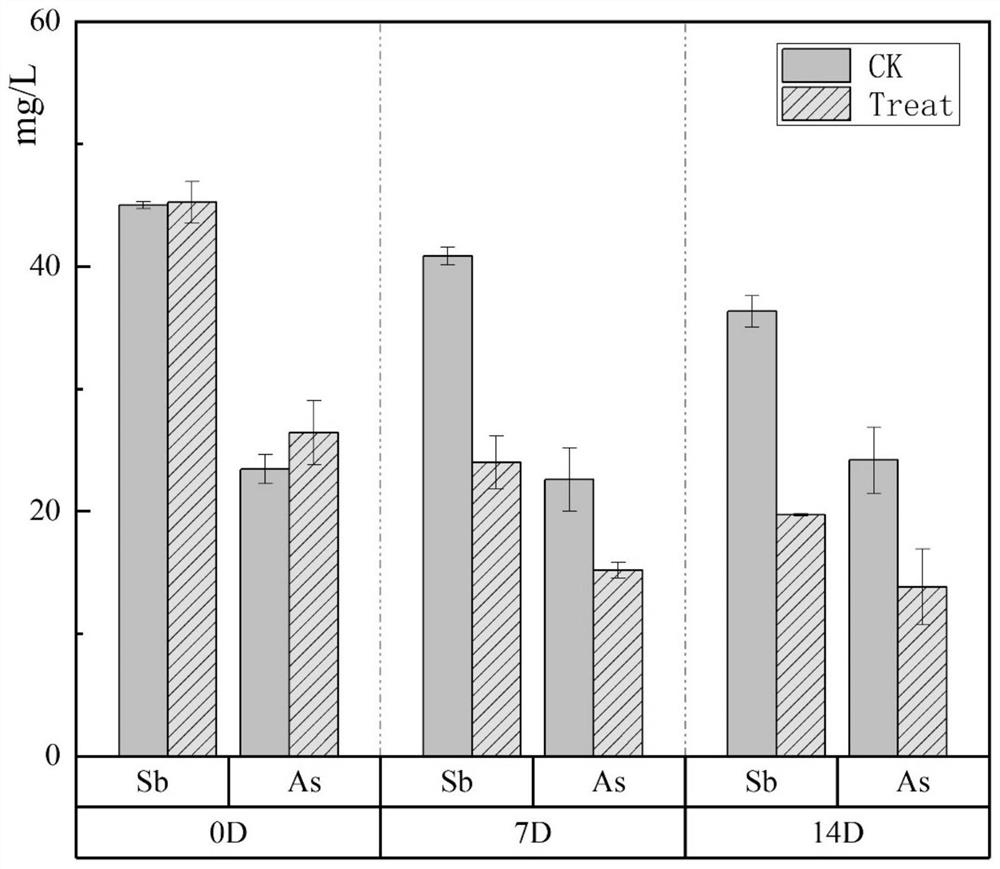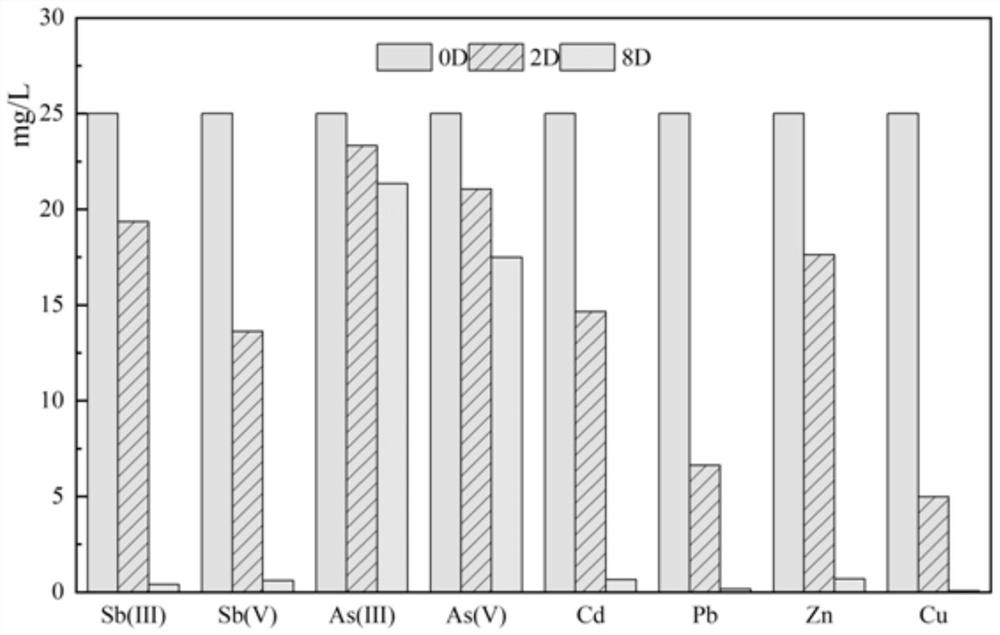Microbial remediation method for polluted soil in antimony ore area
A technology for microbial remediation and contaminated soil, applied in the field of microbial remediation of contaminated soil in antimony mining areas, can solve the problems of secondary pollution, high treatment costs, and large engineering workload, and achieve the effects of promoting growth activity, low cost, and quick results
- Summary
- Abstract
- Description
- Claims
- Application Information
AI Technical Summary
Problems solved by technology
Method used
Image
Examples
Embodiment 1
[0028] Microbial remediation method for polluted soil in antimony mining area
[0029] (1) The isolated and purified Desulfovibrio desulfuricans subsp. Desulfuricans strain was acclimated with heavy metals such as antimony, cadmium, lead, zinc, and copper, and then inoculated into fresh medium with 10% inoculum for anaerobic culture for 3-5 days (1×10 8 CFU / g);
[0030] (2) The inoculum obtained in step (1) is 0.8-1.0L / m 2 Dosage is sprayed into heavy metal contaminated soil for microbial restoration of heavy metal contaminated soil;
[0031] (3) The concentrations of antimony and arsenic ions in soil heavy metal leachate were measured at intervals of 0, 7 and 14 days.
Embodiment 2
[0033] (1) The isolated and purified Desulfovibrio desulfuricans subsp. Desulfuricans strain was acclimated with heavy metals such as antimony, cadmium, lead, zinc, and copper, and then inoculated into fresh medium with 10% inoculum for anaerobic culture for 3-5 days (1×10 8 CFU / g);
[0034] (2) Add white carbon black to the fresh medium, the volume ratio of white carbon black to medium is 1.0-1.2%, stir and mix, add 10% acclimated sulfate-reducing bacteria, stir and mix, pH is adjusted to 7.0 with sodium hydroxide 3-5 days of anaerobic culture at 30°C (1×10 8 CFU / g);
[0035] (3) The inoculum obtained in step (2) is 0.8-1.0L / m 2 Dosage is sprayed into heavy metal contaminated soil for microbial restoration of heavy metal contaminated soil;
[0036] (4) The concentrations of antimony and arsenic ions in soil heavy metal leachate were determined at intervals of 0, 7 and 14 days.
Embodiment 3
[0038] On the basis of step (1), (2) of embodiment 2;
[0039] Prepare fresh medium with antimony (III, V), arsenic (III, V), cadmium, lead, copper and zinc ion concentrations of 25 mg / L respectively, and insert 10% of the sulfate-reducing bacteria obtained in step (2);
[0040] The concentrations of antimony (III, V), arsenic (III, V), cadmium, lead, copper and zinc ions in the solution were measured at intervals of 0 days, 2 days and 8 days.
[0041] like figure 1 As shown in the figure, the removal rates of antimony and arsenic in the polluted soil of the mining area for 14 days by the sulfate-reducing bacteria remediation of the present invention are 33.43% and 48.25%, respectively, as shown in the figure. figure 2 As shown, the removal rates of antimony and arsenic from the polluted soil in the mining area for 14 days after adding silica additives were 56.43% and 47.69%, respectively. The addition of silica additives significantly improved the removal rate of antimony ...
PUM
 Login to View More
Login to View More Abstract
Description
Claims
Application Information
 Login to View More
Login to View More - R&D
- Intellectual Property
- Life Sciences
- Materials
- Tech Scout
- Unparalleled Data Quality
- Higher Quality Content
- 60% Fewer Hallucinations
Browse by: Latest US Patents, China's latest patents, Technical Efficacy Thesaurus, Application Domain, Technology Topic, Popular Technical Reports.
© 2025 PatSnap. All rights reserved.Legal|Privacy policy|Modern Slavery Act Transparency Statement|Sitemap|About US| Contact US: help@patsnap.com



